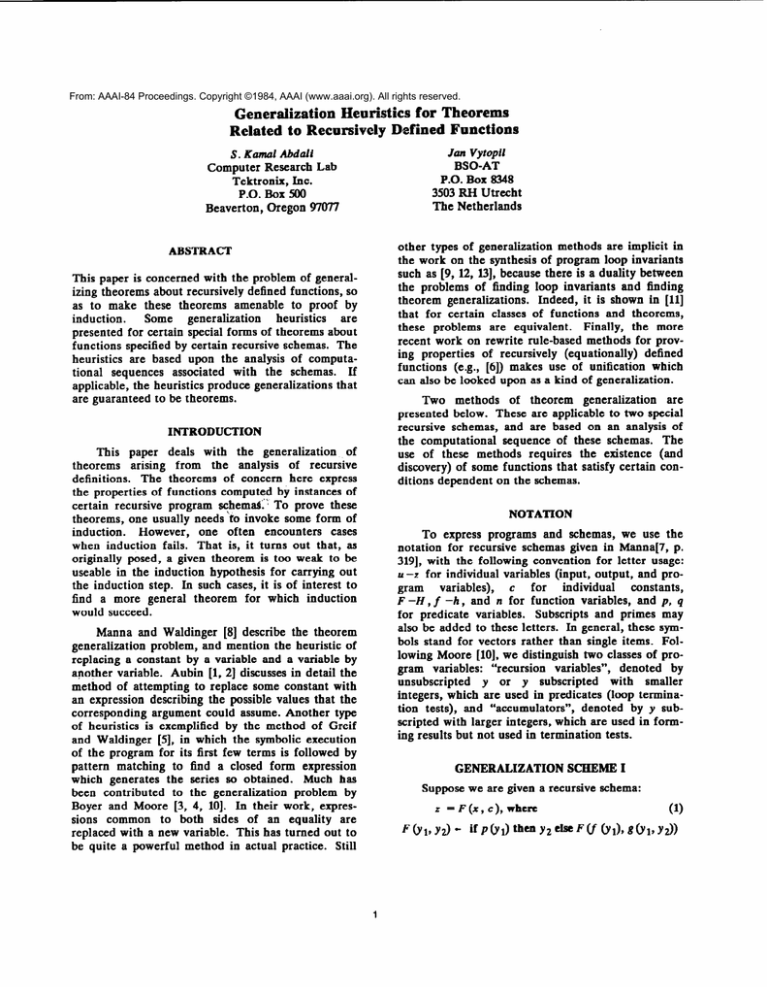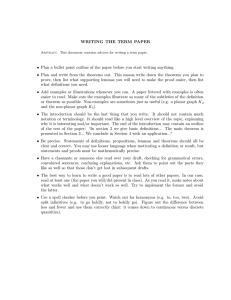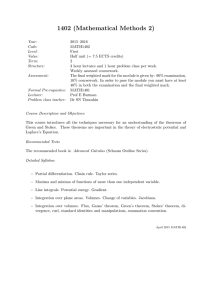
From: AAAI-84 Proceedings. Copyright ©1984, AAAI (www.aaai.org). All rights reserved.
Generalization Hearistics for Theorems
Related to Recarsivcly Defined Fanctions
S. Kamal Abdali
Computer Research Lab
Tektronix, Inc.
P.O. Box so0
Beaverton, Oregon 97077
ABSTRACT
This paper is concerned with the problem of generalizing theorems about recursively defined functions, so
as to make these theorems amenable to proof by
induction.
Some
generalization
heuristics
are
presented for certain special forms of theorems about
functions specified by certain recursive schemas. The
heuristics are based upon the analysis of computational sequences associated with the schemas.
If
applicable, the heuristics produce generalizations that
are guaranteed to be theorems.
INTRODUCTION
This paper deals with the generalization
of
theorems
arising from the analysis of recursive
definitions.
The theorems of concern here express
the properties of functions computed by instances of
certain recursive program w<hern&:: To prove these
theorems, one usually needs to invoke some form of
However,
one often encounters
cases
induction.
when induction fails. That is, it turns out that, as
originally posed, a given theorem is too weak to be
useable in the induction hypothesis for carrying out
the induction step. In such cases, it is of interest to
find a more general theorem for which induction
would succeed.
Manna and Waldinger [8] describe the theorem
generalization problem, and mention the heuristic of
replacing a constant by a variable and a variable by
another variable. Aubin [l, 21 discusses in detail the
method of attempting to replace some constant with
an expression describing the possible values that the
corresponding argument could assume. Another type
of heuristics is exemplified by the method of Greif
and Waldinger [5], in which the symbolic execution
of the program for its first few terms is followed by
pattern matching to find a closed form expression
which generates the series so obtained.
Much has
been contributed to the generalization
problem by
Boyer and Moore [3, 4, lo]. In their work, expressions common to both sides of an equality are
replaced with a new variable. This has turned out to
be quite a powerful method in actual practice. Still
Jan Vytopil
BSO-AT
P.O. Box 8348
3503 RH Utrecht
The Netherlands
other types of generalization methods are implicit in
the work on the synthesis of program loop invariants
such as [9, 12, 131, because there is a duality between
the problems of finding loop invariants and finding
Indeed, it is shown in [ll]
theorem generalizations.
that for certain classes of functions and theorems,
these problems are equivalent.
Finally, the more
recent work on rewrite rule-based methods for proving properties of recursively (equationally)
defined
functions (e.g., [6]) makes use of unification which
can also be looked upon as a kind of generalization.
Two methods of theorem generalization
are
presented below. These are applicable to two special
recursive schemas, and are based on an analysis of
the computational
sequence of these schemas. The
use of these methods requires the existence (and
discovery) of some functions that satisfy certain conditions dependent on the schemas.
NOTATION
To express programs and schemas, we use the
notation for recursive schemas given in Manna[7, p.
3191, with the following convention for letter usage:
u-z for individual variables (input, output, and profor
individual
constants,
gram
variables),
c
F -H, f -h, and n for function variables, and p, q
for predicate variables. Subscripts and primes may
also be added to these letters. In general, these symbols stand for vectors rather than single items. Following Moore [lo], we distinguish two classes of program variables: “recursion variables”, denoted by
unsubscripted
y or y subscripted
with smaller
integers, which are used in predicates (loop termination tests), and “accumulators”,
denoted by y subscripted with larger integers, which are used in forming results but not used in termination tests.
GENERALIZATION
SCHEME I
Suppose we are given a recursive schema:
Z =F(x,c),whcre
~(y~,yz)+
irp0,1)then~zelseFV0,1),g011,~2))
(1)
The generalization
of a theorem
expression (relation) which
Further suppose that for a given interpretation of c,
p, f, g the schema computes a known function G.
That is, for all x for which G(x) is defined, we would
like to prove
F(x,
(2)
c) = G(x)
by
f j(x), i > 0,
the
expression
in which there are i successive
7;
(.$‘gj...))
Further,
we
denote
by
of f.
applications
y f.‘) , yp) , i > 0, the values of the variables yl, y2 on
the i-th iteration of (l), taking yf’), y$‘) to mean x
If, for a given argument x, the
and c, respectively.
value of F (X , c ) is defined, then there must exist an
of
each
that
such
inte er
is
false
and
p(yfL+l))
is
P(Y co’MYf4,....Pcyfi))
true, and the following equalities hold:
YP
for OSiSA,
F(x,c)
has the original theorem as an instance
4
is easier to prove.
=hl(G(x),H(x,c~))
(5)
of (2). The following result states
(a) is satisfied, that is, (5) is indeed
Theorem 1: Let f, g, G be some previously defined
functions, and F, H be defined by the schemas
iIp011)theny2e~FVCy1),80,1,Y2))
FRY+
8 (f(x198(x?c)).-1)
HtYl*
Y2,Y3) + ifdyWeny3
eifie H cf hh
8 01,
YZ),h2691,
Y2, Y3N
If
scf ‘-1w,*..,
scf w
sh
4)“‘))
F(x, c) = G(x)
Note that the depth of recursion, that is the value of
A, depends only on x and not on c.
Suppose we can find two functions
with the property
hlh
b)
as a generalization
that the condition
true.
=yi’+l)
s(u,
we believe is in fact a theorem
F(x,hl(c,z))
and
= scf w,
‘0
be an
We propose
YP’ 'f'(x),
= 8 v i-Yx I,8cfi-2(x
L
should
= hl(g(u,
0
4,
h+,
hl and h2
hl and h2 satisfying
=hl(g(u,v),h2(u,v,w))
S(b
hlh
4)
F(x,
hl(c,
z)) = hl(G(x),H(x,
then
v,
w))-
If we wish to generalize (2) by replacing
h l(c, z ), then the final value of y2 will be
8 cf k (x 198 cf k -‘(xl
and there exist functions
* - - - s g (x 9 MC
(3)
c with
This theorem can be proved by first showing that
under its conditions and definitions, it is the case
that
9 z ND*
Using (3) repeatedly to move hl outwards
we can rewrite this as
c, z))
holds. II
across g,
F(x,
= hl(F(x,
h&w))
w), H(x,
w, z))-
(4)
hlt#+‘),
h2Cf ‘(x),
yjk), h2v ‘-l(x),
hzV 2(x 1, Y i2) 9 hdf
#-‘)
The condition
, . -.,
(x 138 (x 9 c ), h2b 9c 9 z ))))
Au,
+
if Poll)
then
4)
=hddu,v),h2(~,v,w))
does not guarantee that the original theorem is an
instance of the generalized theorem. In general, it is
difficult to state how to derive A, and h2 so that the
original theorem is an instance of the more general
equation (5). Nevertheless, we can state a sufficient
condition for it:
The first argument of hl, ylk+*), is equal to
F (X , c), and the second argument of hl is the iteration of h2 with the first and second arguments having
the same values as they have during the evaluation of
F. Using the definition of F, we can define a new
function H so that H (x, c , z) equals the second argument of hl in (4). This H is defined as follows:
H6%Y2d3)
hl(b
Theorem 2: Under the definitions and conditions of
Theorem
1,
a
sufficient
condition
that
F(x,c)=G(x)
an
F (X , h l(c , z)) = hl(G’[x ), H (x , c , z )p?tk
they:
exist an r such that
Y3
l
elseW
h), gh,
rz),h201, Y~,Y~)I
h&,
r) = u and h2(u,v,r)=r
for all u and v. Ii
2
l
(6)
Although
(6) is not a necessary condition,
experience suggests that it is a natural and easily
Also, although at present
satisfied requirement.
there is no systematic way of finding hI and h2 (if
they exist at all), there are often natural candidates
for these functions, such as addition, multiplication
or append for hl and projection functions for h2.
Note also that while we have only considered
theorems of the type F (x , c) = G (x) for simplicity,
the method can be used for some more complicated
cases such as F (m (x ), A (x)) = G (x ).
A more restrictive heuristic than that given by
Theorems 1 and 2, but one which is particularly simple to use, is described by the following:
Theorem 3: Let f, g, G be some previously
functions, and F be defined by the schema
F&,Y+
defined
The simple choice h (u , v) = append (u , v ) (with nil
for r) satisfies the above conditions.
The generalization of property (9) is thus found to be
rev (X , append (nil , z )) = append (reverse (x ), z ),
that is,
rev (x , z) = append (reverse(x),
This property is provable by induction on x with the
usual definitions of append and reverse.
Example 2: Let F (~1, ~2, ~3) be defined by
F (yl div 2, ~292, if odd(yl) then
Here, yl is the recursion
accumulators.
We have
If
=G(x)
(7)
and there exists a function
that
h and a constant
h(c, z)) = h@(x),
Example 1: Let the function
Y3 else rev w
z)’
(8)
rev(x)
Y2r Y3) = if dd6’1)
and ~2, ~3 are
Y~*YP
then Y2*Y3 ek
YS-
h which satisfies
g(u,v,h(w,z))=h(g(u,v,w),z),
co?ls (cm bl),
env*w
dsew,z).
Also, there must exist an r such that for all u,
To satisfy these requirements,
we can
h(u,r)
=u.
simply take h(u) v) = u *v (with r=l). It is now easy
to see that the property
F (xl, x2, 1) = xf’
be defined by
generalizes
if null 0) *) then y2
64,
go’l,
=h(ifodd(u)tb
(7) is an instance of (8). II
‘4Ylr
= <YI div 2,
else Y3)
ifodd(u)thenv*h(w,z)ebh(w,z)
then it is the case that
Furthermore,
YZ)
Y293
that is,
h(u, r) = u, for all u,
F(x,
variable,
f &,
We look for a function
r such
= h(g(u,v),w)
sw+9w))
x~l=")tbeny3dsc
F(yl&,Y+
~~011)theny2e~F~~1),g~1,~3).
F(x,c)
z)-
to the induction-provable
property
F (xl, x2, z) = (x;‘)*z.
Y2))*
When we try to prove the property
rev (x , nil ) = reverse (x )
by induction on x (reverse being the usual LISP function), we find that the induction step cannot be carried through.
To apply the generalization
method
given above, we observe that
~6’1) = nul%), f (~1)= cdr0,1),
ShY2)
s(Urh(v,w))
h satisfying
=h(g(u,v),w)
that is,
com(car(u),
h(v, w)) = h(cons(car(u),
and also, for some r and all II,
h(u,r)=u.
Suppose we have to prove
F(x, c, c’) CC(X),
F h
Y29 Y3) *
e~wl~f
= coMcdYl)rY2).
We now look for a function
GENERALIZATION SCHEME II
(9
v),
W)
where
if kY2)
(10)
the” Y3
(r2hcy29Y3))
To prove this theorem, we need to carry out
induction
on y2. But this would be impossible
because the initial value of y2 is constant. Therefore
we must generalize (10) by replacing c with a more
general term. In the previous heuristics, we replaced
a constant c with a function h (c , z) and then tried to
determine the influence of this change of initial value
on the final result. It was easy to see how the change
of initial value of an accumulator propagated through
the entire computation,
because of the limited role
played by an accumulator in the function evaluation.
It is harder to apply the same strategy to a recursion
variable.
The initial value of a recursion variable
determines the depth of recursion, and at each level
of recursion, the value of a recursion variable also
affects the final result of computation.
Consequently, the change in the initial value of a recursion
variable has a much more complicated influence on
the computation.
So the function h must be chosen
more carefully, and in fact our choice now is quite
limited. A good strategy would be to replace c with
an expression describing all possible values that this
recursion variable can take on during the computation of F (x , c , c ‘). Suppose we can derive the values
of the recursion variable and the accumulator at the
recursion depth z, say h (z ) and H (z), respectively. If
(10) holds, then
Fh
h(z), H(z))
= G(x)
would be a good generalization,
likely provable by
induction on z (that is, on the depth of recursion).
To find suitable candidates for h(z) and H(z), we
observe that
F(x,c,c? =F(x,f(c),g(c,c?), if c#x,
We define h by
obtaining, simply, h (z ) = z . Also
have
.
‘mill = min (i I (i =x)} = x.
F (x , 0,l)
= min u If i(c)
F(x,z,z!)=x!
W’(x))
FCf'(c),f
= W’(x),
'Cc), e&f'-'(c)r
where h is defined by
lf (y2=O) then M(yI)
hcYl9Yz) -
el=f
(hOI
Y2-w
For example, an M (x) with this property is given by
where
-
if PO*) thenY1 e~wnY1)),
f- is the functional
M(x) = MV(x))
= Mfyx))
= M (pJ(x))
,... &(C, c?...))
h (z ) + if z =0 then c else f (h (z -1)).
= p”“-“(x),
for all
05 z I iti,.
M (h (x , z)) = A4 #i”“(x))
We can therefore
F(x, M(x),
= ---
= f”“(x)
= G(x)
= M (x).
generalize
c? = G(x)
F(x,h(x,z),G(h(x,z))=G(x),
G(h(z)))
f, that is,
into
Then
F(x, h(z),
of
= J’i”‘(x)
h(x, z) = f z @-““‘(x))
So H (i) can simply be replaced by G cf i (c )). We are
thus led to the following
Theorem 4: Let F be defined by (lo), G be some previously defined function, and let
.
zmin=min~Ifj(c)=x),
inverse
. Now we can write
f v(y))=y
gV'-2(c),...~(c,.?)))g
= g(fi-'(c),g(p-2(c)
for all OSzSimin,
= M(x)
whx))
NYl)
c, ~9))) =
for O<ZZX.
In the above discussion, we have used the simplest case of the theorem in (10). Now suppose that
the initial value of y2 is not a constant but some
function M (x). We can derive the value of the accumulator at the recursion depth z if we assume the
case
=x}.
Thus, H(i) =gui-1(c),g(fi-2(c),
. . ., g(c,c?)).
On the other hand, for is itin, we also have
= x!
into
= ... =
if iSid,
in this case we
So we can generalize
=F(x,f2(c),gV(c),g(c,c3)),iff(c)#x,
F (x, f i (c), g cf i-‘(c ), 8 cf i-2(c),m..,tt
(c , c $.J)Xll)
if z=O then 0 else h(z-l)+l,
h(z) -
for O~ZZZ;~~ (12)
for05zlimin.
Using the relation between f and its inverse f-,
above can be rewritten as
iff F(x, c, c? = G(x).
F(x,
h’(x, 4,
G(h’(x,z)))
= G(x),
for 01 z 5 i ‘min,
Example 3: Let the definition
given as
F 619 Y2r Y3) +
else F tit,
if 6YYz)
Y2+1,
of a function
thea
(Y2+l)*Y3)
Y3
F be
where
h ‘(x , z ) + if z =0 then x else r(h ‘(x)),
i ‘tin = min {i Ip (h ‘(x , i))).
the
Example 4: Let the functions
follows:
mYl*
UYI,
A4 and F be defined as
REFERENCES
Y2) + ifYl<Y2~~Y24-wYlJ*y2)
~29 ~39 ~4) *
if cy*=Y2)
1.
Aubin, R.: “Some generalization
heuristics in
proofs by induction”, Proc. IRIA Colloq. on Proving and Improving Programs, Arc et Senans, pp.
197-208 (July 1975).
2.
Aubin,
Ph.D.
(1976).
3.
Boyer, R.S. and Moore, J.S.: “Proving theorems
about LISP functions”, JAChf 22, 1, pp. 129-W
(January 1975).
4.
Boyer, R.S. and Moore, J.S.: A Computatio~l
Logic, Academic Press, New York (1979).
5.
Greif, I. and Waldinger, R.S.: ‘A more mechanical heuristic approach to program verification”,
Proc. Intl. Symp. on Programming, Paris, pp.
83-90 (April 1974).
6.
Huet, GP. and Huillot, J.-M.: “Proof by induction in equational theories with constructors”,
JCSS 25,2, pp. 239-266 (Oct. 1982).
7.
Manna, Z.: Mathematical Theory of Computation,
McGraw Hill, New York (1974).
8.
Manna, Z. and Waldinger, R.: “‘Synthesis: dreams
- programs”, IEEE Trans. Software Engintering,
SE-S, 4, pp. 294-328 (July 1979).
9.
Misra, J.: “Some aspects of the verification of
loop
computations”,
IEEE Trans. Software
Engineering, SE4,6, pp. 478-486 (Nov. 1978).
then <Y39 Y4’
(y3 2 y2 div 2)
ekif
then F bl, y2 div 2,y3 - y2 div 2, 2*y4+l)
else F 011, ~2 div 2, ~3~2~4)~
Since (292) div 2 = ~2,
method, generalizing
we
can
F (x2, M (xl, xz), x1, 0) = <xl
apply
the
above
mod x2, x1 div x2>
into
F(~~,h(x~,z),xlm~h(x2,z),~1d~vh(x2,~))
= <x1 mod x2, x1 div x2>
for Oszziimin,
where
h(.Yl,Yz) *
if y2= 0 then y 1 dse 2*h (yr, y2-1),
that is,
WYl,
Yz) = eY1.
CONCLUSION
We have discussed the problem of generalizing
theorems about recursively defined functions in such
a way that the generalized form of the theorems is
more amenable to proof by induction.
We have
presented, motivated, and illustrated some heuristics
for carrying out the generalization
for certain patterns of theorems and recursive definitions.
R.: “Mechanizing structural induction”,
dissertation,
University
of Edinburgh
10. Moore, J.S.: “Introducing iteration into the pure
LISP theorem prover”, IEEE Trans. Software
Engineering, SE-I, 3, pp. 328-338 (May 1975).
11. Morris, HJ. and Wegbreit, B.: “Subgoal induction”, CACM 20,4, ~~209-222
(April 1977).
Our heuristics are given in terms of definitional
schemas.
Given a functional definition, we try to
find a matching schema and look for certain auxiliary
functions satisfying some conditions
dependent on
the schema. This seems to be a systematic approach,
as opposed to the ad hoc approach of, say, replacing
constants by expressions. Furthermore, our generalization heuristics have been derived by analyzing
recursive computational sequences.
Whenever these
heuristics apply, the generalized theorems are true if
and only if the original theorems are true. This is
not the case with the heuristics currently found in
the literature. It may be possible to apply similar generalization
methods to other types of definitional
schemas, and develop a catalog of heuristics for
different patterns of recursive definitions.
12. Tamir, M.: “ADI: Automatic
derivation
of
invaraiants”, IEEE Trans. Sofhvare Engineering,
SE-6, 1, pp. 40-48 (Jan. 1980).
13. Wegbreit,
CACM
5
B.: ‘The synthesis of loop predicates”,
pp. 102-112 (Feb. 1974).
17,2,





